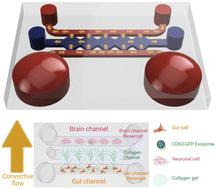Our official English website, www.x-mol.net, welcomes your
feedback! (Note: you will need to create a separate account there.)
Development of in vitro model of exosome transport in microfluidic gut-brain axis-on-a-chip
Lab on a Chip ( IF 6.1 ) Pub Date : 2024-09-04 , DOI: 10.1039/d4lc00490f Gwang Myeong Seo 1 , Hongki Lee 2 , Yeon Jae Kang 1 , Donghyun Kim 2 , Jong Hwan Sung 1
Lab on a Chip ( IF 6.1 ) Pub Date : 2024-09-04 , DOI: 10.1039/d4lc00490f Gwang Myeong Seo 1 , Hongki Lee 2 , Yeon Jae Kang 1 , Donghyun Kim 2 , Jong Hwan Sung 1
Affiliation

|
The gut communicates with the brain in a variety of ways known as the gut–brain axis (GBA), which is known to affect neurophysiological functions as well as neuronal disorders. Exosomes capable of passing through the blood–brain-barrier (BBB) have received attention as a mediator of gut–brain signaling and drug delivery vehicles. In conventional well plate-based experiments, it is difficult to observe the exosome movement in real time. Here, we developed a microfluidic-based GBA chip for co-culturing gut epithelial cells and neuronal cells and simultaneously observing exosome transport. The GBA-chip is aimed to mimic the in vivo situation of convective flow in blood vessels and convective and diffusive transport in the tissue interstitium. Here, fluorescence-labeled exosome was produced by transfection of HEK-293T cells with CD63-GFP plasmid. We observed in real time the secretion of CD63-GFP-exosomes by the transfected HEK-293T cells in the chip, and transport of the exosomes to neuronal cells and analyzed the dynamics of GFP-exosome movement. Our model is expected to enhance understanding of the roles of exosome in GBA.
中文翻译:

微流体肠脑轴芯片中外泌体运输的体外模型的开发
肠道以多种称为肠脑轴(GBA)的方式与大脑进行交流,众所周知,它会影响神经生理功能以及神经元疾病。能够穿过血脑屏障(BBB)的外泌体作为肠脑信号传导和药物输送载体的介质而受到关注。在传统的基于孔板的实验中,很难实时观察外泌体的运动。在这里,我们开发了一种基于微流控的 GBA 芯片,用于共培养肠上皮细胞和神经元细胞,并同时观察外泌体运输。 GBA芯片旨在模拟血管中的对流流动以及组织间质中的对流和扩散传输的体内情况。在此,荧光标记的外泌体是通过用 CD63-GFP 质粒转染 HEK-293T 细胞而产生的。我们实时观察芯片中转染的HEK-293T细胞分泌CD63-GFP-外泌体,并将外泌体转运至神经元细胞,并分析GFP-外泌体运动的动态。我们的模型有望增强人们对外泌体在 GBA 中作用的理解。
更新日期:2024-09-04
中文翻译:

微流体肠脑轴芯片中外泌体运输的体外模型的开发
肠道以多种称为肠脑轴(GBA)的方式与大脑进行交流,众所周知,它会影响神经生理功能以及神经元疾病。能够穿过血脑屏障(BBB)的外泌体作为肠脑信号传导和药物输送载体的介质而受到关注。在传统的基于孔板的实验中,很难实时观察外泌体的运动。在这里,我们开发了一种基于微流控的 GBA 芯片,用于共培养肠上皮细胞和神经元细胞,并同时观察外泌体运输。 GBA芯片旨在模拟血管中的对流流动以及组织间质中的对流和扩散传输的体内情况。在此,荧光标记的外泌体是通过用 CD63-GFP 质粒转染 HEK-293T 细胞而产生的。我们实时观察芯片中转染的HEK-293T细胞分泌CD63-GFP-外泌体,并将外泌体转运至神经元细胞,并分析GFP-外泌体运动的动态。我们的模型有望增强人们对外泌体在 GBA 中作用的理解。


















































 京公网安备 11010802027423号
京公网安备 11010802027423号